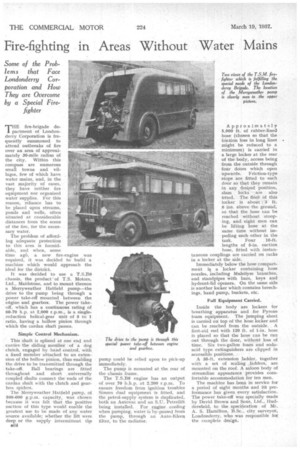Fire-fighting in Areas Without Water Mains
Page 114

If you've noticed an error in this article please click here to report it so we can fix it.
Some of the Problems that Face Londonderry Corporation and How They are Overcome by a Special Fire
fighter
THE fire-brigade department of Londonderry Corporation is frequently summoned to attend outbreaks of fire over an area of approximately 30-mile radius of the city. Within this compass are numerous small towns and villages, few of which have water mains, and, in the vast majority of cases, they have neither fire equipment nor organised water supplies. For this reason, reliance has to be placed upon streams, ponds and wells, often situated at considerable distances from the scene of the fire, for the necessary water.
The problem of affording adequate protection to this area is formid able, and when, some
time ago, a new fire-engine was required, it was decided to build a machine which would approach the ideal for the district.
It was decided to use a T.S.B9 chassis, the product' of T.S. Motors, Ltd., Maidstone, and to mount thereon Merryweather Hatfield pump--the drive to the pump being through a power take-off mounted between the engine and gearbox. The power takeoff, which has a continuous rating of 60-70 h.p. at 2,000 r.p.m., is a singlereduction helical-gear unit of 5 to I ratio, having a hollow pinion through which the cardan shaft passes.
Simple Control Mechanism.
This shaft is splined at one end and . carries the sliding member of a dog clutch, engaged by hand control, with a fixed member attached to an extension of the hollow pinion, thus enabling the drive to be transmitted through the take-off. Ball bearings are fitted throughout and short ,universally coupled shafts connect the ends of the cardan shaft with the clutch and gearbox spiders.
The Merryweather Hatfield pump, of 500-600 g.p,ru. capacity, was chosen because it was felt that the positive suction of this type would enable the greatest use to be made of any water source available; whether the lift were deep or the supply intermittent the 64 pump could be relied upon to pick-up immediately.
The pump is mounted at the rear of the chassis frame.
The T.S.B9 engine has an output of over 70 b.h.p. at 2,200 r.p.m. To ensure freedom from ignition troubles Simms dual equipment is fitted, and the petrol-supply system is duplicated, both an Autovac and an S.U. Petrolift being installed. For engine cooling when pumping, water is by-passed from the pump, through an Auto-Kleen filter, to the radiator.
Approximately 5,000 ft. of rubber-lined hose (chosen so that the friction loss in long lines might. be reduced to a minimum) is carried in a large locker at the rear of the body, access being from the outside through four doors which open upwards. Friction-type stops are fitted to each door so that they remain in any desired position, slam locks are also fitted. The flool Of this locker is about 3 ft. 6 ins, above the ground, so that the hose can be reached without stooping, and eight men can be lifting hose at the same time without impeding each other in the task. Four 10-ft. lengths of 5-in, suction hose, fitted with instantaneous couplings are carried on racks in a locker at the side.
Immediately below the hose compartment 4 a locker containing hose nozzles, including Mulsifyre branches, and standpipes with bars, keys and hydrant-lid openers. On the same side is another locker which contains breechings, hand pump, buckets, etc.
Full Equipment Carried.
Inside the body are lockers for breathing apparatus and for Pyrene foam equipment. The jumping sheet is carried on top of the hose locker and can be reached from the outside. A first-aid reel with 120 ft. of 1-in, hose is placed so that the hose can be run out through the door, without loss of time. Six two-gallon foam and sodaacid type extinguishers are clipped in accessible positions.
A 35-ft. extension ladder, together with a set of scaling ,ladders, are mounted on the roof. A saloon body of streamline appearance provides comfortable accommodation for ten men.
The machine has been in service for a period of eight months and its performance has given every satisfaction. The power take-off was specially made by David Brown and Sons, Ltd., Huddersfield, to the specification of Mr. A. S. Hamilton, B.Sc.', city surveyor, Londonderry, who was responsible tot the complete design.
























































































































































